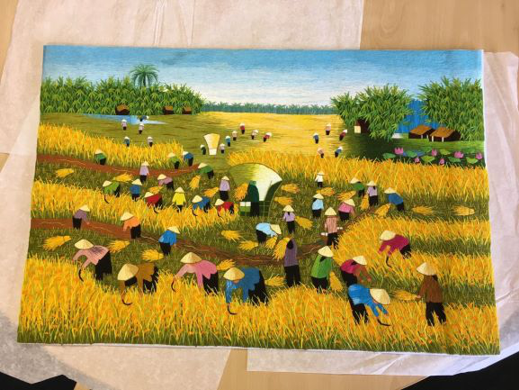Blog
Framing your crossstitch and embroidery: My Top Tips
Framing your crossstitch and embroidery: My Top Tips
From the first look, it is clear how much time, concentration and patience goes into these creations. So, putting as much or more effort into stretching, mounting and framing is paramount.
 In this blog, you will learn some top tips about the processes and techniques that ensure the artwork is protected from dust, moisture and harmful UV rays, whilst also displaying in an attractive frame and mount – allowing the designs to be seen at their best.
In this blog, you will learn some top tips about the processes and techniques that ensure the artwork is protected from dust, moisture and harmful UV rays, whilst also displaying in an attractive frame and mount – allowing the designs to be seen at their best.
Cleanliness is key
Aida and other embroidery cloths attract dirt like a magnet attracts iron filings, so cleanliness when handling is essential. Make sure to wear protective gloves to avoid too much hand washing, and store the material in clean, tissue lined folders between working sessions. Both of these rituals should be applied from the outset of your embroidery project and remain your responsibility, even if you eventually decide to get the assistance of a professional framer.
To ensure the best possible results, most framers insist the onus is on the customer for ensuring that the cross stitch or embroidery is clean (and where appropriate pressed NB: not always appropriate) when it arrives at the framers. However, with antique and old fabrics, advice should be sought from a conservator before washing, as irreversible damage can be caused if treated with an inappropriate technique.
Ultimately, always be aware that dirty patches on the cloth will be magnified under glass. So, work in a clean environment, and remember to wear protective gloves.
Cut Ample Cloth
To avoid the time-consuming process of a donor fabric needing to be used, the amount of cloth that borders the embroidery should be taken into consideration, as an insufficient border will be difficult to square and stretch. As a guide, take the anticipated visible area of the image and add at least 2 inches (50mm) from the perceived sight edge - this can be folded over the support board during the squaring process. With older pieces that may have been cut or sewn on small cloths without good borders, a donor fabric is necessary.
Your donor fabric choice will need some careful consideration. Firstly, choosing the right colour; on the thinner pieces this can affect the colour from the front. Secondly, the type of material, which needs to hold the embroidery in place securely but not be allowed to overstretch fabric it is holding.
The Right Support is Essential
The backing board is used to support the fabric during the squaring process. It needs to be pH neutral, cotton rag or conservation board, and the right colour. It is amazing how the colour choice of the board can affect the overall appearance of the finished framed artwork.
Aida cloth has a relatively open weave and therefore the colour of the board beneath tends to show through, creating a hue that may or may not be aesthetically pleasing. Care should be taken during this stage to source the right colour. The acidity of the support board will have an adverse effect on the fabric and stitching if the wrong board is used - choosing a Fine Art Trade Guild certified conservation board is a good idea. For valuable pieces, a cotton rag board is often the best option, as they do not contain lignin. Lingin can cause discolouration and an increase in acidity as it breaks down, damaging the cloth.
To best preserve valuable or sentimental fabric art a pH neutral cotton board should be used. However, for the hobbyist, a conservation (pH neutral) quality board is a good, more affordable option. The board should be cut perfectly ‘square’ and to the appropriate size for your embroidery picture. To check this, measure the diagonal corners and ensure that they are equal to each other, whether cutting a square or a rectangle. Square up and stretch.
Lastly, the cloth needs to be accurately centred on the board so that the visible area of the cross stitch or embroidery displays correctly in the final window mount. Using a 2400 micron (2.4mm) thick support board offers both stability and a suitable edge to pin the cloth to the support, prior to sewing in the stretching cotton. Use 50mm T pins so repositioning of the fabric is possible before attempting the next process. The cotton embroidery thread is thinned as appropriate to the cloth, so that the cotton is the weaker of the two but strong enough to provide the amount of tension required.
A single length of thread is used to stretch the fabric. So, as the stretching cotton is sewn into the reverse of the cloth between 10mm and 20mm intervals, the cotton is drawn all the way through, and the end is temporarily wound around the nearest pin to prevent it being pulled right through. It is best to work left to right then top to bottom, easing the thread to the right tension; ending at the starting point. The pins are now removed and the fabric left to 'rest' for 24 hours, before the final tensioning and tie off.
Adding your Mount and Glass
There are many different manufacturers of varying quality mount boards. I always choose a fine art trade guild certified conservation board with a significant range of colours to suit a variety of jobs.
Begin by measuring the dimensions of the ‘window’ in the mount, and the height and the width in millimetres (or imperial if you prefer). Next, decide on the width of the border you want. There are no hard and fast rules on border size, but a lot of framers use the ‘Golden Ratio’ - this seems to offer a visually balanced end result.
With the opening and the border decided, the outer dimensions of the frame can then be determined.
Mounts can be configured in a multitude of ways, and I generally choose a double or triple mount that allows for a higher degree of creativity. However, it is wise to plan this in advance, so that the frame you choose has a suitably deep rebate to hold the ‘package’ when it’s stacked ready to frame.
Multiple mounts also offer the chance to introduce some highlight colours to enhance the finished frame, so choosing complementary, analogous or monochromatic colours can help to define and showcase the embroidery. The choices of colour can be:
• Complementary Colours (Opposite sides of colour wheel): This creates an exciting, outgoing feel with a strong contrast. Joyful.
• Analogous Colours (Side by side on colour wheel): Creates a strong visual impact whilst staying in harmony with the artwork. Sophisticated.
• Monochromatic Colours (Same hue so no contrast): Creates a feeling of understated unity.
Your picture frame glass should be suitable for the protection and conservation of the artwork or textile you are framing. Choosing a 99%UV glass is right for historic, valuable or highly sentimental pieces, where 2mm float glass or acrylic might be more suited to hobbyists, or those with children. An anti-reflective glass is ideal to enhance viewing pleasure, and has no bearing on the preservation of the embroidery within.
Frame it
There are a few rules of thumb when choosing a frame:
• Rebate Depth: Measure the depth of the art package before ordering the frame, remember you’ll need the depth of the package plus 2-3 mm extra so the package can be suitably held in place.
• Frame Width, Colour, Profile and Finish: Choosing a colour and finish that suits the work, is it contemporary, modern or antique. Consider your desired effect - simple, ornate, elegant?
• Frame Material: Whilst most frames are wood and finished with a foil, paint job or kept barewood, there are also Artcore and aluminium frames to choose from, and you’ll the need the right tools to ensure you can cuts the mitres accurately.
Once the frame is cut and joined the final stage of constructing the final picture can begin.
Putting it all together
When all of the elements are together and stacked into a package, a final cleaning session is advised before they can be put into the frame. This is to remove any dust, cotton balls or other debris from the artwork, mount and glass. Then, an anti-static brush can be lightly dusted over the surfaces. Pay meticulous attention to detail, as it’s too late to make changes once the frame is loaded, pinned and sealed.
Next, ‘clamp’ the package, bulldog clips are useful here, and seal around the edges of the package with a suitable self-adhesive tape. Now load the whole package by gently sliding it towards the bottom of the frame before lowering into the top edge. Hold the frame and package together securely and look to make a final check that everything is in place without any ingress of dust or dirt.
The frame can now be pinned and sealed, preventing access of foreign bodies from the rear of the frame and giving a lovely, finished feel. Attach the wire or cord on either side, 1/3 of the way down, and screw in a few D-rings, taking care to choose screws that don’t penetrate the viewing side of the frame.
And the frame is finished. Now, you can step back and admire your work.


